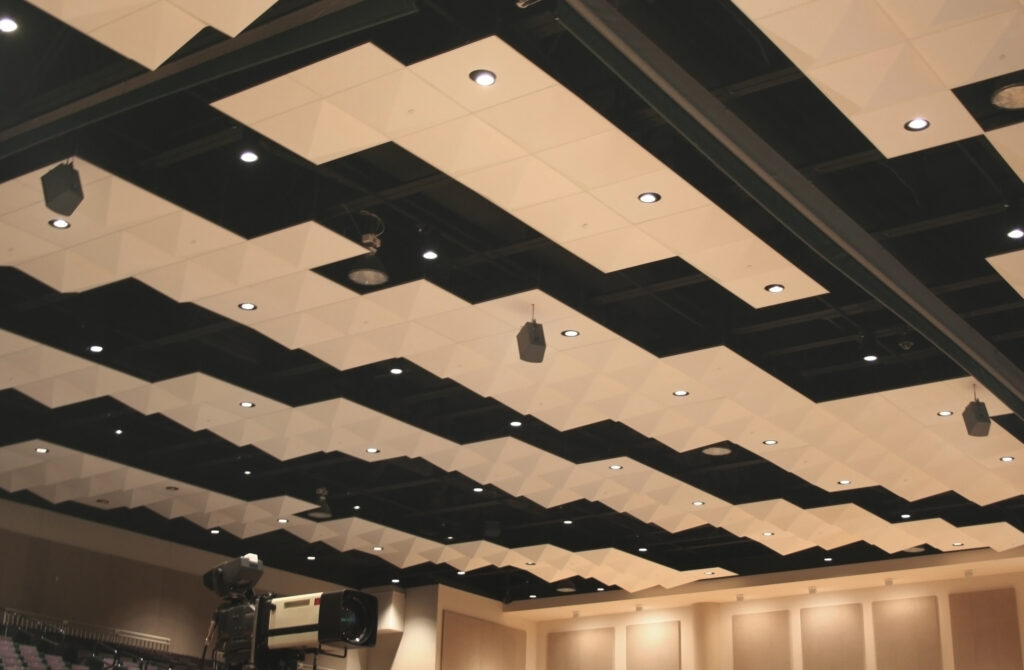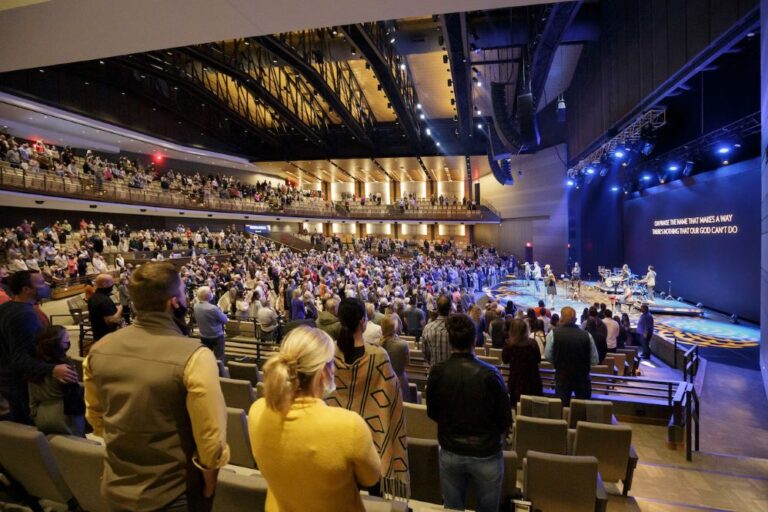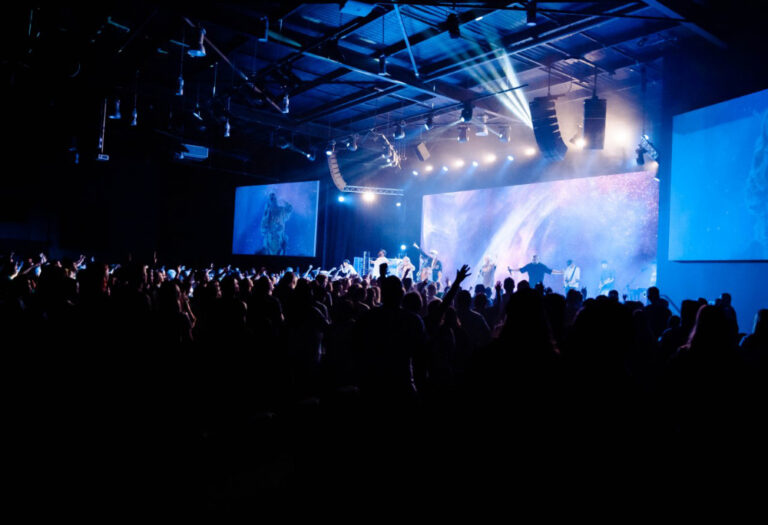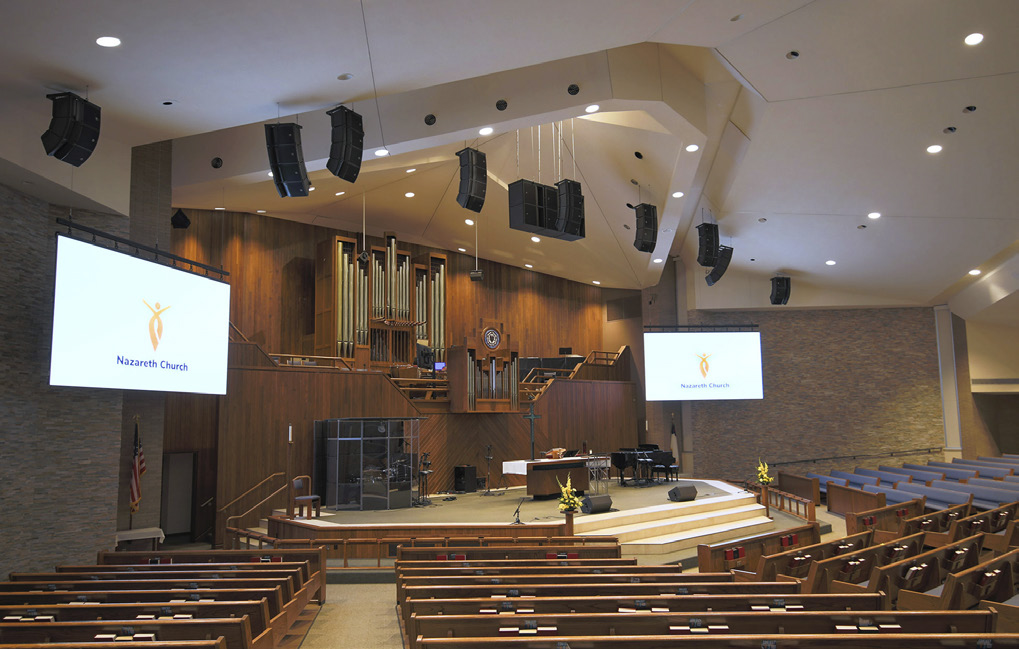In the world of sound there’s an old adage that states, “Your system is only as good as the weakest component in the signal chain.” This is especially true of a system’s loudspeakers. They are the last link in the chain and are directly responsible for communicating everything that’s been done to the signal along the way.
Going beyond simply delivering sound into a room, they actually become a living physical element, dynamically interacting with their surroundings. In other words, what you’re usually hearing from a loudspeaker is more than its output, you’re also hearing what’s happening to that output as it travels through the space.
Selecting the “right” loudspeakers for a given system and room is no simple matter, and there can be more than one “right” answer. The type of programming featured in worship services is one issue; the acoustical nature of the space is another. Budgetary issues are almost always an important factor influencing loudspeaker selection. Aesthetics are yet another concern.

The only certainty is that every single situation is different and needs to be treated as such. That’s why there’s a constantly growing selection of loudspeaker types and deployments available for church applications, including:
Point Source. A single loudspeaker system of two- or three-way design. These provide very good coherence compared to multi-box systems (assuming the single box is well-designed), and present a huge variety of configurations, performance levels and price-points.
Column. A loudspeaker system typically consisting of identical smaller drivers arranged vertically in a single enclosure. These can work well with speech, and are small and visually unobtrusive. Some models have advanced digital signal processing that allow their output to be “steered” or more precisely focused on the coverage area.
Distributed. Multiple (usually smaller format) loudspeakers spread about the coverage area. These are usually used in conjunction with a main system to provide supplemental coverage to areas that are hard to reach otherwise. They may be a winning solution for acoustically difficult or irregularly shaped spaces, but can add complexity, requiring a good deal of digital signal processing and deft tuning.

Cluster. Groups of point source loudspeakers, perhaps including individual horns or low-frequency boxes. This is a very flexible option in achieving the desired coverage, and can provide high-acoustic output. However, they often require a skilled system design to work well, and sometimes are not very visually appealing. As a result, it may be preferred to place behind a scrim, which adds complexity and cost.
Line Array. Multi-way loudspeaker systems that are specifically designed to be deployed in vertical arrays. Over the past 20 years or so, line arrays have become very popular for church sound applications. They offer good flexibility in achieving the desired coverage, very high acoustic output, and good coherence when properly deployed. The downside is that the arrays can be quite large and may not blend well with décor, and because many loudspeakers are required, cost can add up pretty quickly.
In addition, the number of loudspeakers equipped with their own power and processing (commonly called self-powered) has dramatically expanded. They can deliver extremely good performance because all of the elements can be optimized to work well together, and because they’re “closed systems,” there’s less chance of unauthorized adjustments being made that will degrade system performance.
Self-powered loudspeakers can also reduce or eliminate the need for amplifier rack rooms and long, expensive cable runs. The trade-off (there’s always a trade-off in audio) is that AC power must be brought to the loudspeaker location(s). With proper planning this is easily done for new construction, but it may be a bigger undertaking for retrofits.
Talking Tech
Let’s take a look at key specifications of loudspeakers, starting with the one that gets thrown around (and is misunderstood) the most: watts. Stating “it’s a 5,000-watt loudspeaker” (usually followed by an exclamation point) doesn’t tell us much except that the loudspeaker is rated (often in some vague way) to handle up to 5,000 watts of audio power.
But this does not tell us what the loudspeaker does with that power or how loud it is. That’s the job of the sensitivity specification, which states in decibels (dB) how loud a particular transducer will play given a particular input, usually referenced to 1 watt of input signal measured at 1 meter distance from the driver.

Simply put, the higher the number, the louder the output. Thus a loudspeaker with a lower wattage rating but a higher sensitivity rating can have a louder output than one with a higher wattage rating but lower sensitivity.
Note that the dB measurement uses a logarithmic scale where each mark on the scale is the previous mark multiplied by a value or number. In decibels, a 10 dB increase in level is roughly equivalent to a “doubling” of perceived loudness.
So if one loudspeaker has a rated sound pressure level (SPL) of 80 dB and another is rated at 90 dB, the second loudspeaker is generally perceived to be about twice as loud to the average person.
Another key specification is coverage pattern, which is stated in horizontal and vertical angles referenced to the centerline of the enclosure. The key here is to remember that dispersion characteristics are frequency dependent, meaning that a loudspeaker may (and usually does) exhibit different patterns at different frequencies.
For example, a basic two-way model with a front-mounted 15-inch woofer and compression driver on a horn may have a stated coverage pattern of 90 degrees horizontal by 60 degrees vertical (90° x 60° for short), but the lower frequencies produced by the woofer are basically omnidirectional.
Thus the stated coverage pattern might not actually begin to happen until the point where higher frequencies emanate from the driver/horn, say 1.6 kHz and above. And then at the top range of the audible scale, say 16 kHz, the pattern may actually narrow because higher frequencies tend to be more directional. Reputable manufacturers publish polar plots that detail how their products behave at different frequencies.

Tighter coverage pattern control is important for two primary reasons. First, we want audio energy to go where the audience is located while staying off of walls and ceilings where it can bounce around. This reflected energy hampers clarity and intelligibility, often significantly.
Second, we may want to place a few loudspeakers next to each other (in clusters) so that they can cover a wider area. Knowing the coverage pattern helps in this regard in general, and the more controlled the pattern, the less the loudspeakers will destructively interfere with each other.
With the same audio signal emanating from two or more transducers (woofers and drivers) in the typical loudspeaker, sound from each transducer arrives at the listener at slightly different times. Depending on the frequency and the distance between the transducers, the signals will be out of phase with each other, with respect to the listener.
This interference is called comb filtering, and it can be constructive (additive) or destructive (subtractive), changing the quality of the audio depending on the listener’s location. Indoors, where we hear a mixture of direct and reflected sound, comb filtering can also occur because the reflected sound reaches our ears at a different time than the direct sound. Taking care not to overlap the coverage patterns of loudspeakers and keeping unwanted energy off of room boundaries can go a long way in improving audio quality.
Developing A Gameplan
With all of these choices and factors (and more) in play, selecting loudspeakers for a church system can be a daunting task to say the least. The following suggestions are intended to help point you in the right direction, no matter what type of loudspeaker you’re evaluating.

Keep in mind that A/B comparisons are quite useful; it’s best to compare similar products in similar situations. On their own, most loudspeakers can sound at least “OK,” but a side-by-side comparison makes the differences more obvious.
It’s also highly recommended that you work with qualified sound system consultants and/or contractors to insure optimum results, both in terms of selection as well as proper (and safe!) installation.
Decide on standards of comparison. Next to great sound (which is a subjective decision), determine what is most important to you. Size, price, reliability? Before beginning listening evaluations, narrow the field to a few systems. This list of candidates should be as closely equivalent to each other as possible with regard to the criteria that you determine as most important in your purchasing decision.
Use familiar material. If possible, try to arrange for a live comparison of your leading loudspeaker candidates in the space where they’ll be used, or at least a space with similar characteristics. Clergy and lay celebrants should speak through the system – when listening, determine which loudspeaker sounds closest to the natural vocal signature of the people talking. With music, choose selections you’re familiar with, and ones that mirror the types of music featured at your services.
Use your ears, not your eyes. As you look at your potential loudspeaker choices, you’ll soon discover that manufacturers use a wide range of measurement standards when creating specifications for their loudspeakers. By all means, read the product literature – it can sometimes offer valuable information. But remember, listening to comparable systems is the only test of actual performance.
Use your feet as well as your ears. You’ll start out standing right in front of the loudspeaker, but most of the audience will not be sitting there – they spread out far and wide. Listen to how the sound changes as you move to the side, above and below, close up and far away. Ask your contractor how much of the space the system is intended to cover, then walk that space as you listen.
Listen to collaborators. Most people can easily recognize a “good” loudspeaker system. Natural, undistorted sound makes a distinctive impression on which you and the other members of your tech and worship teams (as well as pastors and the building committee, if applicable) can agree.
Focus on the voice. The spoken word should be reproduced as naturally as possible to accurately convey full content and emotion.
Keep in mind that many loudspeaker manufacturers provide very good technical service and support departments, a valuable resource that can help in sorting through the possibilities. In fact, numerous manufacturers provided us with great input in the course of preparing this article.




















